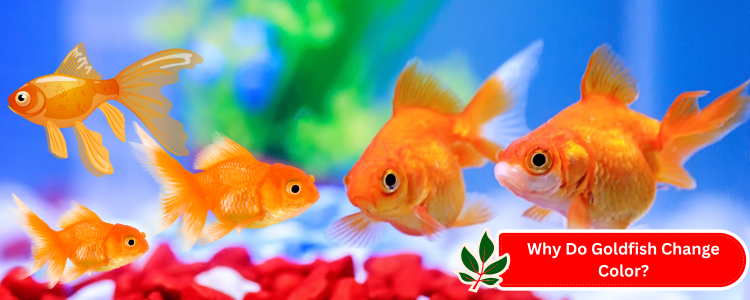Goldfish change color due to genetics, diet, lighting, and water conditions. These factors influence pigment cells in their skin.
Goldfish are beloved pets, admired for their brilliant colors. Over time, however, many owners notice their fish’s colors fading, darkening, or even changing entirely. This transformation, while fascinating, often raises questions. Genetics are a primary factor in determining a goldfish’s color. Certain foods can also boost or maintain their vibrant hues.
Lighting in the tank affects the intensity of their colors. Inadequate or excessive light exposure can lead to noticeable changes. Similarly, water quality and temperature play a critical role in maintaining their coloration. By focusing on these key areas—diet, lighting, and water—goldfish owners can better support their pets’ natural beauty and health.
The Color-changing Phenomenon
Goldfish color changes are natural. It’s not a cause for alarm in most cases. Their colors may fade, darken, or even transform completely. This ability is linked to their biology and surroundings.
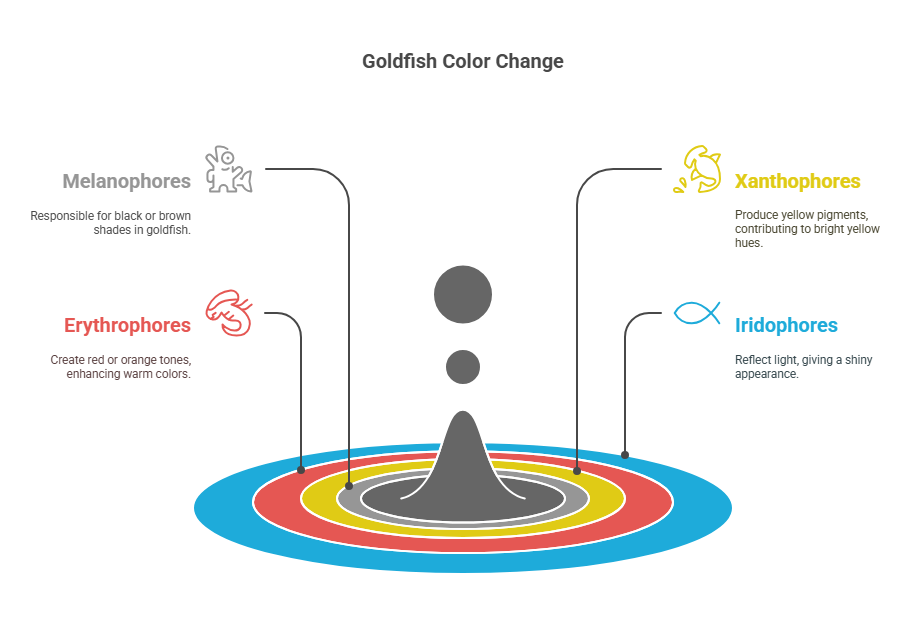
Natural Habitats and Color Variations
Goldfish originated in East Asia. In the wild, they’re less colorful, blending with their environment for protection. Domestic goldfish, bred for vibrant hues, display a broader range of colors like orange, red, white, black, and yellow.
| Habitat | Common Colors |
|---|---|
| Ponds | Brown, Green |
| Rivers | Golden, Brown |
| Lakes | Green, Brown |
| Home Aquariums | Bright Gold, Orange |
Myths vs. Facts
Myth: Goldfish change color due to mood.
Fact: Their colors shift because of genetics, environment, or health factors. Mood plays no role.
Myth: Adding specific chemicals can permanently change their color.
Fact: While some supplements enhance color, permanent changes often rely on genetics or environmental conditions.
Genetics and Coloration
Goldfish are captivating creatures, celebrated for their vivid colors. However, did you know that their coloration is significantly influenced by genetics? By delving into the genetic factors, we can unravel the mystery behind the color changes in goldfish over time.
Inheritance Patterns
Genes dictate a goldfish’s initial color. Some genes trigger melanin production, giving darker shades, while others boost carotenoids, creating vibrant orange and red hues. Mutations can also lead to unique patterns or colors.
Here’s a simple breakdown:
| Gene Type | Expression |
|---|---|
| Dominant | More likely to show |
| Recessive | Less likely to show |
Goldfish can change color if their recessive genes become dominant.
Selective Breeding Impact
Breeders select goldfish for specific traits. Over generations, this has created varieties like Shubunkins and Orandas. Each variety has unique patterns and colors. The downside? Some traits make them more prone to color changes.
Environmental Influences
Goldfish are celebrated for their vibrant colors, but these hues can sometimes change. A key factor behind this phenomenon is environmental influences. This section delves into how various environmental factors impact the color of goldfish.
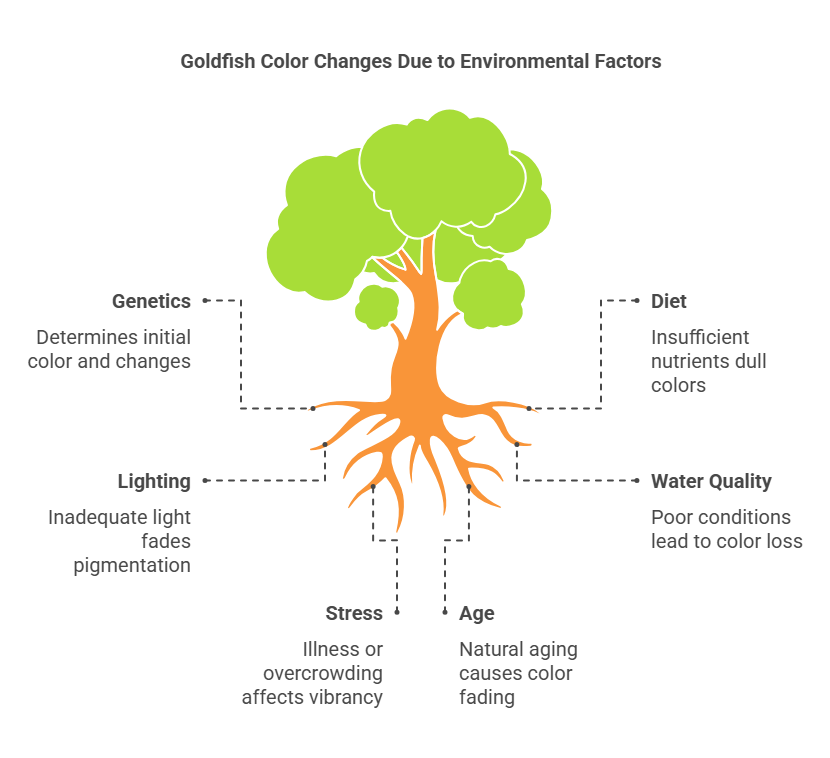
Water Quality and Parameters
Water conditions greatly impact goldfish color. Poor water quality can dull their hues. Ensure proper filtration and frequent water changes. Optimal water temperature (65-75°F) helps maintain their vibrant appearance. Extreme temperatures stress them, leading to faded colors.
| Parameter | Ideal Range |
|---|---|
| Ammonia | 0 ppm |
| Nitrite | 0 ppm |
| pH | 7.0 – 8.4 |
Light Exposure and Intensity
Light affects their pigment cells. Insufficient light can cause colors to fade. Goldfish in well-lit environments tend to retain their vivid shades. Natural sunlight is ideal but avoid prolonged direct exposure.
Dietary Factors
Goldfish are captivating creatures, capable of changing color due to a variety of factors. One significant factor is their diet. The food goldfish consume can greatly influence their vibrant colors. Let’s delve into how dietary factors contribute to this transformation.
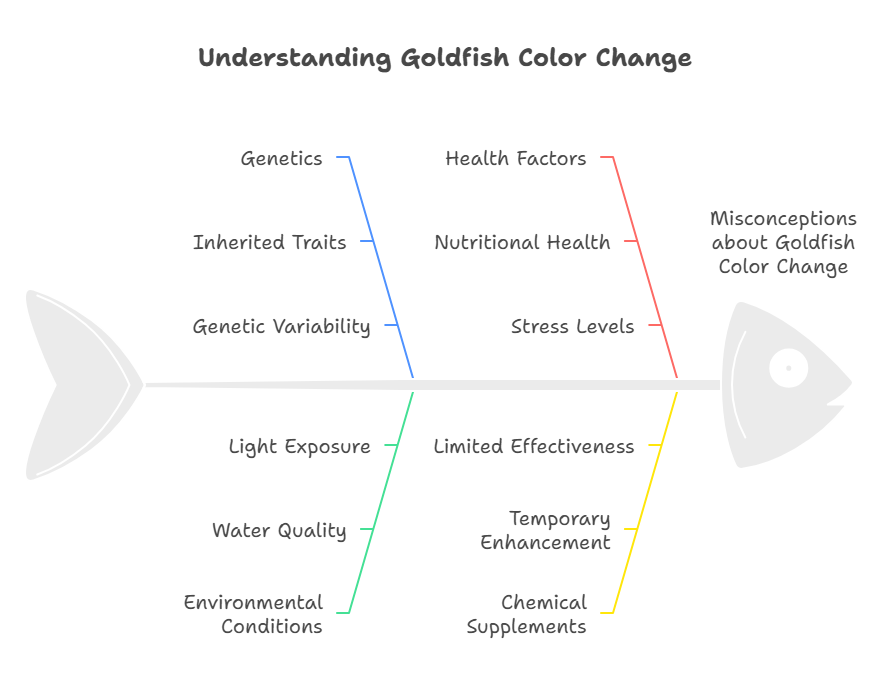
Nutritional Components
A goldfish’s diet influences its coloration. Foods rich in carotenoids, like carrots or spirulina, enhance their natural hues. Protein-rich diets also promote vibrant scales.
Some common carotenoid-rich foods include:
- Carrots
- Sweet potatoes
- Spinach
- Peas
Supplements and Color Enhancement
Commercial goldfish foods often include color enhancers. Look for foods labeled with natural pigments. Avoid overfeeding as it can harm their health.
Here is a simple table to understand the color enhancement options:
| Type | Description |
|---|---|
| Color-enhancing flakes | Flakes with added carotenoids |
| Liquid supplements | Nutrient-rich liquids added to water |
Health and Physiology
Goldfish are celebrated for their vibrant colors, which can change due to various health and physiological reasons. Gaining an understanding of why these changes occur can aid in their care and maintenance. Let’s delve into some key factors that influence this fascinating phenomenon.
Disease and Stress Effects
Illness or stress can lead to faded colors. Common stressors include poor water conditions, overcrowding, and sudden temperature changes. Healthy goldfish are typically more vibrant.
Age-related Changes
Goldfish colors often change as they age. Juvenile goldfish start with duller shades, developing brighter colors over time. Older goldfish may experience fading due to pigment loss.
This is a natural process and not usually a cause for concern.
| Age Stage | Color Characteristics |
|---|---|
| Juvenile | Bright and vibrant colors |
| Adult | Stable color, slight fading possible |
| Senior | Noticeable fading, color changes |
Understanding the reasons behind goldfish color changes can help you provide better care. Always monitor their health and environment to ensure they thrive.
The Role of Pigment Cells
Goldfish are celebrated for their vibrant colors, which are produced by pigment cells in their skin. These specialized cells, known as chromatophores, are responsible for changing the fish’s color. By understanding these cells, we can better comprehend why goldfish undergo color changes.
Types of Chromatophores
Goldfish have specialized pigment cells called chromatophores. These include:
- Melanophores: Responsible for black or brown shades.
- Xanthophores: Produce yellow pigments.
- Erythrophores: Create red or orange tones.
Melanin and Carotenoids
Melanin provides darker colors, while carotenoids create brighter hues. A balance between these pigments results in goldfish’s stunning shades.
Melanin: found in melanophores, is the pigment that gives goldfish their dark colors. Variations in melanin levels can cause a goldfish to become darker or lighter.
Carotenoids: are pigments responsible for red, orange, and yellow hues. Goldfish obtain these pigments from their diet. Insufficient carotenoids can result in goldfish losing their bright colors.
The balance of melanin and carotenoids influences the goldfish’s color. Both pigments play a key role in the fish’s appearance.
| Chromatophore Type | Pigment | Color |
|---|---|---|
| Melanophores | Melanin | Black/Brown |
| Xanthophores | Carotenoids | Yellow |
| Erythrophores | Carotenoids | Red |
| Iridophores | Reflect Light | Shiny |
Understanding these pigment cells helps explain why goldfish change color. The environment, diet, and health all impact these changes.
Adaptive Purposes
Goldfish can change color for a variety of reasons, with one of the most intriguing being for adaptive purposes. These color changes enhance their ability to survive and communicate effectively within their environment.
Camouflage and Survival
In the wild, color changes help goldfish blend into their environment, avoiding predators. This survival mechanism is less needed in aquariums but remains part of their biology.
Here’s a simple table to show color changes for camouflage:
| Water Type | Goldfish Color |
|---|---|
| Muddy | Darker |
| Clear | Lighter |
| Green Algae | Greenish |
Social Signaling
Goldfish sometimes change colors to communicate with other fish. It’s subtle but essential in their social interactions.
Human Influence
Goldfish frequently change color as a result of human influence. This occurs due to several factors introduced by human activities. Let’s delve into how human actions impact the color changes in goldfish.
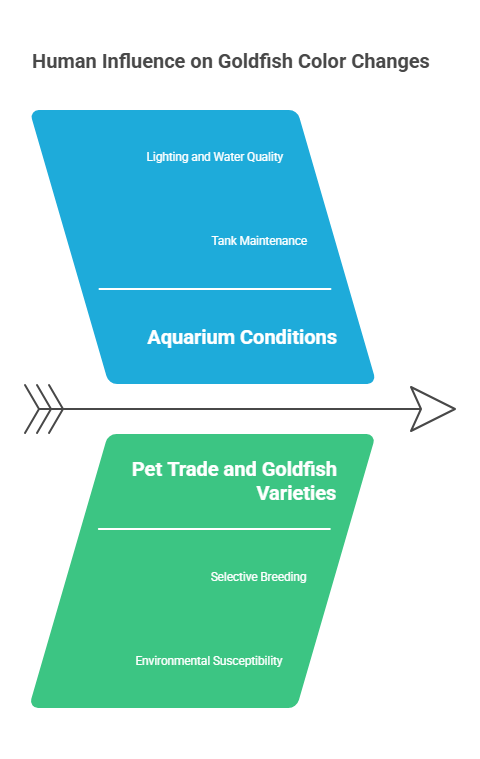
Aquarium Conditions
Tank environments play a major role. A clean tank with proper lighting and water quality helps goldfish maintain their colors. Crowded tanks or poor maintenance can dull their appearance.
The Pet Trade and Goldfish Varieties
The pet trade promotes diverse goldfish varieties, each with unique colors. This demand encourages selective breeding, but it also increases their susceptibility to environmental factors.
Moving goldfish to a new home also impacts their color. They may change color as they adapt to their new environment.
| Human Activity | Effect on Goldfish Color |
|---|---|
| Poor Water Quality | Color Fading |
| Improper Lighting | Turning White or Pale |
| Unbalanced Diet | Dull Colors |
| Selective Breeding | Unique Color Patterns |
| Stressful Conditions | Color Changes |
Conclusion
Goldfish can undergo color changes due to factors such as diet, light, and genetics. Understanding these reasons aids in providing better care for your fish. Observing goldfish color changes can be both fascinating and informative. By maintaining optimal conditions, you can ensure your goldfish remain healthy and vibrant.
FAQs
Q: Why is my goldfish turning white?
A: It could be due to poor lighting, aging, or a health issue. Improve tank conditions and consult a vet if needed.
Q: Can I prevent color changes in goldfish?
A: While you can’t stop all changes, maintaining proper diet, water quality, and lighting minimizes them.
Q: Are color-enhancing foods safe?
A: Yes, as long as they are natural and given in moderation.
Q: Do all goldfish change color?
A: Most do to some extent, but the degree varies based on genetics and environment.
Q: Does stress affect goldfish color?
A: Yes, stress can dull their colors. Ensure they have a clean, spacious tank to thrive.

